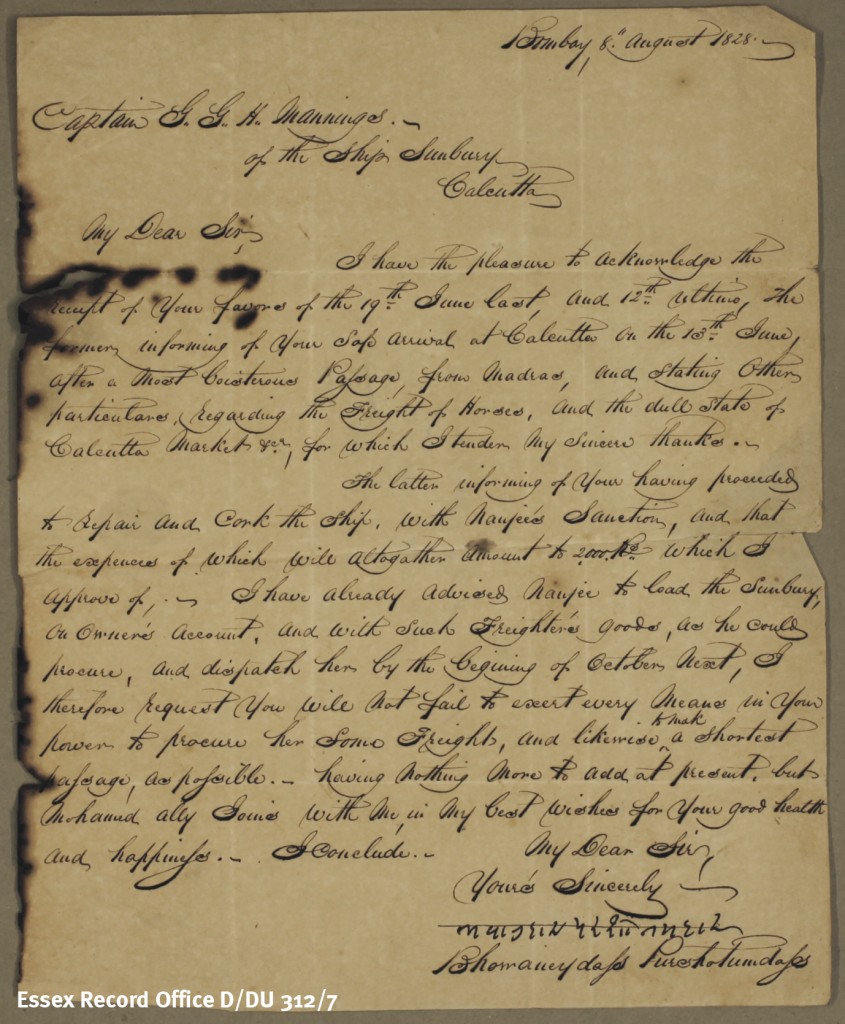As October is Black History Month, we have chosen for our Document of the Month something from our small but significant collection which reflects the history of Black, Asian and Minority Ethnic communities and their connections to Essex.
The document is a letter from Bhowaneydass Purshotumdass in Bombay to Captain G. G. H. Munnings (referred to in the letter as ‘Mannings’) dating from 1828 (D/DU 312/7). While the letter raises more questions than it answers, it gives us a tantalising glimpse into the world of trade in India in the nineteenth century.
We can glean from the letter that Munnings was employed by Purshotumdass, and that he had just arrived in Calcutta on the Sunbury from Madras, a journey of 800 miles along the Bay of Bengal from the south to the north of the country. Judging by the need to ‘repair and cork the ship’, the writer’s reference to a ‘boisterous passage’ from Madras to Calcutta by Captain Munnings would seem to be an understatement.
It appears that the main purpose of the journey was to transport horses to Calcutta, but Purshotumdass wanted the vessel to return with as full a cargo and as quickly as possible to maximise profits, as is the case with international trade today.
Unfortunately, no other letters between the pair survive; we don’t know for how long he was employed by Bhowaneydass Purshotumdass, or what goods he found for the return journey.
At present, we have been able to find out a little about Captain Munnings but nothing about Bhowaneydass Purshotumdass.
What we do know is that Captain Munnings was from a family from Thorpe-le-Soken, and his full name was George Garnett Huske Munnings. Poll books available on Ancestry describe Captain Munnings as a merchant; the burial registers of St. Stephen Coleman Street in the City of London record that he was buried in that parish in 1837.
Other records show that Munnings owned a number of ships involved in both domestic and international trade. Some of his vessels operated up and down the coast of East Anglia, while others plied their trade to India and the West Indies.
Bhowaneydass Purshotumdass has signed the letter twice; in English and possibly in Marathi (a language used in Bombay). He was clearly an educated and wealthy man; it is difficult to translate the 2,000 rupees he mentions to a modern day equivalent, but by the end of the 19th century, 15 rupees equated to £1.
The letter will be on display in the Searchroom throughout October 2014.
Do you have a story to tell about the past or present of a Black, Asian or Minority Ethnic (BAME) community in Essex? If so we want to hear from you.
We are inviting people from BAME communities to tell their stories, either by writing them down or making a sound or video recording, to be kept in the archive for current and future generations to share.
This will be an ongoing project, but in order for potential contributors to see where their stories will be stored, we are holding a launch event with an opportunity to see behind-in-scenes at the archive, and to enjoy food, music, and a display of documents. Come and join in with Essex History Needs You on Saturday 11 October 2014, 11.00am-2.00pm. Free entry, just drop in. More information here.

